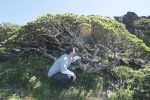Jin / shari?
3 posters
Page 1 of 1
 Jin / shari?
Jin / shari?
are they necessarily interrelated? Is it good form to have a jin emerging from a shari, or is it not 'compulsory'?

bobby little- Member
 Re: Jin / shari?
Re: Jin / shari?
THE definitive answer:
It depends:
On the tree,
on its shape,
on its (apparent) age
on what you like.
In MY humble opinion, too many of today's bonsai have too much deadwood on them. Less is more.
It depends:
On the tree,
on its shape,
on its (apparent) age
on what you like.
In MY humble opinion, too many of today's bonsai have too much deadwood on them. Less is more.

JimLewis- Member
 Re: Jin / shari?
Re: Jin / shari?
Bobby,
The answer to your question has direct relevance to the design you have in mind. For instance, a lot of people add shari and jin elements to trees that naturally do not have them present in nature, like bougainvillea. To keep my explanation on track and to further answer your inquiry, depending on the tree species and the ecological factors involved in the creation of natural shari, you will often see them occur simultaneously.
I. How to diferentiate jin and shari
The simplest way to diferentiate jin and shari is by using a half-way peeled bannana as reference; the uncovered, skinless top part being the jin and the area partially covered by the peel, the shari. In shari creation, a carefully drawn plan must be envisioned. Dead wood elements, when properly placed, can enhace the beauty of the material. On another note, creating shari (or Sari in chinese) without a purpose, detracts beauty from the material.
Diversity and flow can bring the outmost beauty on dead wood. As stated by my teacher, Cheng Cheng Kung, in points where branches meet, the better three dimensional elements can be uncovered, thus giving quality to the variation of the line and fibers in the dead elements. Shari and jin are medals given to trees that have withstood against the elements of nature. The are a reward given to trees that have struggled with adversity and have overcome. There are several points that are pivotal in shari creation. Let's see:
1) have material that lends itself for jin and shari elements
2) have the proper sharp tools to achieve your design (perhaps the most important)
3) make sure you understand the way the sap flows on the material to be used.
4) when creating shari, make sure that the sanshue (water line) revolves and twists around the dead wood. This is very important. If water lines are situated on the eiter side of the dead protions, it will look like a tanuki
5) In the process of creation, always follow the grain of the wood. The process of shari creation is one of discovery. By eliminating the redundant portions of a tree, fiber by fiber, we will uncover the inner beauty of the wood.
II. Types of Sidiao (silk fiber carving)
The art of Sidiao is a path of discovery. By peeling the fibers of dead wood, we can uncover the diversity an inner beauty of dull-rounded wood. Like a diamond cutter, the creator uses very sharp tools to precisely eliminate the portions of the wood that don't contribute to his vision and design.
a. Mechanical Sidiao
Mechanical Sidiao is reffered to as the process of using air driven (best) or electrical (2nd best) tools to create jin and shari on trees with short-tight fiber. Examples of these trees are, pemphis acidula, premna and conocarpus. Since the wood on these trees is dense and short, manual sidiao is not well suited for the creation af dead elements in the material. some manual tools can be used, but the mayority of the work is performed mechanically.
b. Manual Sidiao
Manual sidiao is the process of using hand held burins and chisels to create dead elements. This method is particularly suited for conifers loke pines and junipers. For this material, mechanical sidiao is only performed o eliminate large portions of the tree. The remainig work is done manually.
III. How to preserve dead wood
Lime sulphur is the best solution to preserve dead portions on a bonsai. Some people use oils and wood harderners, but they only seal the surface portion of the wood, thus creating a formidable atmosphere for humidity and fungus. In order to mimic the natural color of natural driftwood, a couple of drops of india ink should be added to the lime and sulphur mix.
IV. The mistake of torching
A lot of artists torch both, newly created shari and exisitng driftwood on trees to create cracks and crevices. This is a big mistake. By torching the wood, one eliminates the natural oils and minerals that contribute to its hardness. Also, by extracting these essential elements, we accelerate the decay process. This is further evidenced by the crack and crevices that result from torching (the wood shrinks).
I hope this small details help you in your path for jin and shari creation. You can learn more at www.sidiao.com .
Kind regards,
Jose Luis
The answer to your question has direct relevance to the design you have in mind. For instance, a lot of people add shari and jin elements to trees that naturally do not have them present in nature, like bougainvillea. To keep my explanation on track and to further answer your inquiry, depending on the tree species and the ecological factors involved in the creation of natural shari, you will often see them occur simultaneously.
I. How to diferentiate jin and shari
The simplest way to diferentiate jin and shari is by using a half-way peeled bannana as reference; the uncovered, skinless top part being the jin and the area partially covered by the peel, the shari. In shari creation, a carefully drawn plan must be envisioned. Dead wood elements, when properly placed, can enhace the beauty of the material. On another note, creating shari (or Sari in chinese) without a purpose, detracts beauty from the material.
Diversity and flow can bring the outmost beauty on dead wood. As stated by my teacher, Cheng Cheng Kung, in points where branches meet, the better three dimensional elements can be uncovered, thus giving quality to the variation of the line and fibers in the dead elements. Shari and jin are medals given to trees that have withstood against the elements of nature. The are a reward given to trees that have struggled with adversity and have overcome. There are several points that are pivotal in shari creation. Let's see:
1) have material that lends itself for jin and shari elements
2) have the proper sharp tools to achieve your design (perhaps the most important)
3) make sure you understand the way the sap flows on the material to be used.
4) when creating shari, make sure that the sanshue (water line) revolves and twists around the dead wood. This is very important. If water lines are situated on the eiter side of the dead protions, it will look like a tanuki
5) In the process of creation, always follow the grain of the wood. The process of shari creation is one of discovery. By eliminating the redundant portions of a tree, fiber by fiber, we will uncover the inner beauty of the wood.
II. Types of Sidiao (silk fiber carving)
The art of Sidiao is a path of discovery. By peeling the fibers of dead wood, we can uncover the diversity an inner beauty of dull-rounded wood. Like a diamond cutter, the creator uses very sharp tools to precisely eliminate the portions of the wood that don't contribute to his vision and design.
a. Mechanical Sidiao
Mechanical Sidiao is reffered to as the process of using air driven (best) or electrical (2nd best) tools to create jin and shari on trees with short-tight fiber. Examples of these trees are, pemphis acidula, premna and conocarpus. Since the wood on these trees is dense and short, manual sidiao is not well suited for the creation af dead elements in the material. some manual tools can be used, but the mayority of the work is performed mechanically.
b. Manual Sidiao
Manual sidiao is the process of using hand held burins and chisels to create dead elements. This method is particularly suited for conifers loke pines and junipers. For this material, mechanical sidiao is only performed o eliminate large portions of the tree. The remainig work is done manually.
III. How to preserve dead wood
Lime sulphur is the best solution to preserve dead portions on a bonsai. Some people use oils and wood harderners, but they only seal the surface portion of the wood, thus creating a formidable atmosphere for humidity and fungus. In order to mimic the natural color of natural driftwood, a couple of drops of india ink should be added to the lime and sulphur mix.
IV. The mistake of torching
A lot of artists torch both, newly created shari and exisitng driftwood on trees to create cracks and crevices. This is a big mistake. By torching the wood, one eliminates the natural oils and minerals that contribute to its hardness. Also, by extracting these essential elements, we accelerate the decay process. This is further evidenced by the crack and crevices that result from torching (the wood shrinks).
I hope this small details help you in your path for jin and shari creation. You can learn more at www.sidiao.com .
Kind regards,
Jose Luis
Last edited by jrodriguez on Wed Aug 19, 2009 4:25 pm; edited 2 times in total

jrodriguez- Member
 Re: Jin / shari?
Re: Jin / shari?
Blimey Jose. That was very kind of you to go to those lengths. I have now set up a file on my p.c. to save all the useful info people have given me, because my head is too small to retain it all. Thank you very kindly. 

bobby little- Member
 Similar topics
Similar topics» Bonsai Shari Sidiao
» Treating jin and sharis
» shari on yaupon?
» Treating shari on oak
» Bonsai shari sidiao
» Treating jin and sharis
» shari on yaupon?
» Treating shari on oak
» Bonsai shari sidiao
Page 1 of 1
Permissions in this forum:
You cannot reply to topics in this forum






